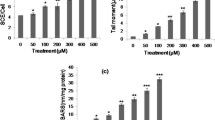Abstract
In this research, the genotoxic and antigenotoxic effects of methanol extract of Sempervivum armenum (MSA) were studied using micronucleus (MN) test and sister chromatid exchange (SCE) test systems in cultured human peripheral blood cells. According to the SCE and MN tests results, MSA reduced the genotoxic effects of aflatoxin B1. In order to explain the reason for the antigenotoxic effects of MSA, antioxidants levels were determined. Cotreatments of 5, 10, 20 mg/mL concentrations of MSA with aflatoxin B1 decreased the frequencies of SCE, MN and the malondialdehyde level and increased the amount of superoxide dismutase, glutathione and glutathione peroxidase which were decreased by aflatoxin. The results of this experiment showed that MSA has strong antioxidative and antigenotoxic effects and this antigenotoxic activities of MSA can be due to the antioxidant activities.


Similar content being viewed by others
References
Abram V, Donko M (1999) Tentative identification of polyphenols in Sempervivum tectorum and assessment of the antimicrobial activity of Sempervivum L. J Agr Food Chem 47:485–489
Alberti A, Blazics B, Kery A (2008) Evaluation of Sempervivum tectorum L. flavonoids by LC and LC−MS. Chromatographia 68:107–111
Alpsoy L, Yildirim N, Agar G (2009) The antioxidanteffects of vitamin A, C, and E on aflatoxin B1-induced oxidative stress in human lymphocytes. Toxicol Ind Health 25:121–127
Alpsoy L, Aslan A, Kotan E et al (2011) Protective role of two lichens in human lymphocytes in vitro. Fresen Environ Bull 20:1661–1666
Anar M, Orhan F, Alpsoy L et al (2013) The antioxidant and antigenotoxic potential of methanol extract of Cladonia foliacea (Huds) Willd. Toxicol Ind Health 32:721–729
Andersen JK, Mo JQ, Hom DG, Lee FY, Harnish P, Hamill RW, McNeill TH (1996) Effect of buthionine sulfoximine, a synthesis inhibitor of the antioxidant glutathione, on the murine nigrostriatal neurons. J Neurochem 67:2164–2171
Baytop T (1999) Türkiye’de Bitkilerle Tedavi. 2.baskı, 480 sayfa, Nobel Tıb Kitabevi, İstanbul
Boissier PE, Huet du Pavillon A (1856) Diagnoses plantarum orientalium novarum. serie 2, vol. 3. Ginebra, Leipzig, París, Como
Countryman PI, Heddle JA (1976) The production of micronuclei from chromosome aberrations in irradiated cultures of human lymphocytes. Mutat Res 41:321–332
Davis PH, Mill RR, Tan K (1988) Sempervivum L. In: Davis PH, Mill RR, Tan K (eds) Flora of Turkey and East Aegean Islands (Supplement I), vol 10. Edinburgh Univ. Press, Edinburgh
Güner A, Özhatay N, Ekim T et al (2000) Flora of Turkey and the East Aegean Islands, vol 11. Edinburgh University Press, Edinburghs, pp 127–134
Karaer F, Celep F (2010) Taxonomic notes on Sempervivum armenum boiss. & A. Huet (Crassulaceae) from Turkey with an amended description. Bangladesh J Bot 39:103–105
Kekesi G, Dobos I, Benedek G et al (2003) Antinociceptive activity of Sempervivum tectorum L. extract in rats. Phytother Res 17:1032–1036
Lin J, Opoku AR, Geheeb-Keller M et al (1999) Preliminary screening of some traditional Zulu medicinal plants for anti-inflammatory and anti-microbial activities. J Ethnopharmacol 68:267–274
Muirhead CW (1972) Sempervivum L. In: Davis PH (ed) Flora of Turkey and East Aegean Islands, vol 4. Edinburgh University Press, Edinburgh, pp 209–248
Ohkawa H, Ohishi N, Yagi K (1979) Assay for lipid peroxides in animal tissues by thiobarbituric acid reaction. Anal Bıochem 95:351–358
Ozhatay FN, Kultur S, Gurdal MB (2011) Check-list of additional taxa to the supplement Flora of Turkey V. Turk J Bot 35:589–624 doi:10.3906/bot-1101-20
Paglia DE, Valentine WN (1967) Studies on the quantitative and qualitative characterization of erythrocyte glutathione peroxidase. J Lab Clin Med 70:158–169
Sedmikova M, Reisnerova H, Dufkova Z et al (2001) Potential hazard of simultaneous occurrence of aflatoxin B1 and ochratoxin A. J Vet Med Czech 46:169–174
Sengul Koseoglu M (2014) Investigation of heavy metals content in medicinal plant Sempervivum armenum Boiss. & Huet Huet subsp. armenum (Crassulaceae) from Erzurum, Turkey. Res J Chem Environ 18:2–12
Signorini ML, Gaggiotti M, Molineri A et al (2012) Exposure assessment of mycotoxins in cow’s milk in Argentina. Food Chem Toxicol 50:250–257
Speit G, Haupter S (1985) On the mechanism of differential Giemsa staining of bromodeoxyuridine-substituted chromosomes. Hum Genet 70:126–129
Stojicevic SS, Stanisavljevic IT, Velickovic DT et al (2008) Comparative screening of the anti-oxidant and antimicrobial activities of Sempervivum marmoreum L. Extracts obtained by various extraction techniques. J Serb Chem Soc 73:597–607
Sun Y, Oberley LW, Li Y (1988) A simple method for clinical assay of superoxide dismutase. Clin Chem 34:497–500
Tietze F (1969) Enzymic method for quantitative determination of nanogram amounts of total and oxidized glutathione: applications tomammalian blood and other tissues. Anal Biochem 27:502–522
Topalov K, Mort ME, Neeff P et al (2006) Preliminary phylogenetic analyses of Sempervivum L. (Crassulaceae) inferred from DNA sequence data. In: Botany 2006 Conference Abstract, California State University, Chico, p 300
Zeybek N, Zeybek U (1994) Farmasotik Botanik Ege Universitesi Basım Evi, 201,İzmir
Acknowledgments
This research was financed by a grant from Erzincan University Research Funds. The authors are grateful to Erzincan University for financial support (Project No: BAP SAG-A-140613-0029).
Author information
Authors and Affiliations
Corresponding author
Ethics declarations
Conflict of interest
The authors have no conflict of interest to disclose.
Rights and permissions
About this article
Cite this article
Sunar, S., Anar, M., Sengul, M. et al. Antioxidant and antigenotoxic potencies of Sempervivum armenum on human lymphocytes in vitro. Cytotechnology 68, 2355–2361 (2016). https://doi.org/10.1007/s10616-016-0030-y
Received:
Accepted:
Published:
Issue Date:
DOI: https://doi.org/10.1007/s10616-016-0030-y



